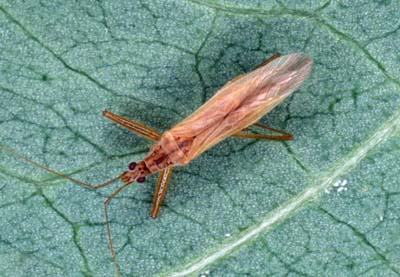
Adult Nabis americoferus, a damsel bug.
(Photographer: James Castner, University of Florida)
Male and female damsel bugs of the same species are similar in size (about 0.9 cm in length) and appearance. They have slender grayish-brown or tan bodies, long antennae, thickened forelegs (used for grasping prey) and elongated heads with strongly developed "beaks." Damsel bugs move rapidly when disturbed. The nymphs are similar in color to the adults, but are smaller in size and do not possess fully developed wings.
Damsel bug adults and nymphs overwinter in debris or other protected areas. During the spring, adult damsel bugs become active and begin to lay eggs until the end of summer. Typically, there are two to three generations per year.
Damsel bugs are predaceous and are found in open fields and on many perennial non-orchard crops throughout the United States.
Damsel bugs feed on aphids, caterpillars, beetle larvae and other true bugs.
Images
To save the Web-optimized images shown below to your hard drive:
|
Click to access Display and Print quality images. |